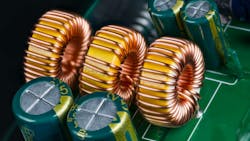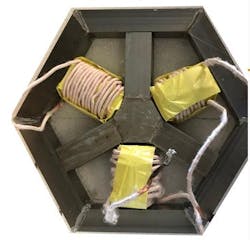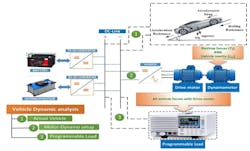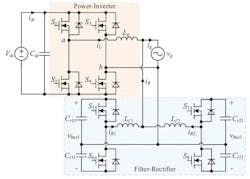Shedding Light on Little-Known Power-Density Applications
What you'll learn:
- Differentiating between energy and power.
- Elevating power density in EV design with a three-phase inductor.
- Use of power filters in grid-connected inverters.
Simply put, power density is a quantity that can output large amounts of energy based on its volume. Here’s a simple example:
A small capacitor could have the same power output as a large battery. Since the capacitor is far smaller, it will have a higher power density because it can release energy very quickly. High-power-density systems also have the capability to recharge quite fast.
What’s the Difference Between Energy and Power?
Power and energy are quite different terms that may sometimes be used interchangeably (Fig. 1). However, these terms aren’t identical.
Their relation is given in the equation:
Power × Time = Energy
Energy is defined as the amount of work that’s able to be done. Power is the rate at which energy is used to do that work—in other words, the amount of energy used per unit of time.
Why High Power Density for an Electric Vehicle?
The shift toward electrified transportation has elevated the importance of interleaved DC-DC converters, as well as integrated magnetic components, targeted for increased power density and system efficiency. 3,4 A step-up DC-DC converter, like an interleaved boost converter, is needed between the traction inverter and the battery pack to increase the usable voltage to the necessary high voltage level.
In a majority of EVs, due to the room taken up by the battery pack, the remaining usable space must be distributed between inverters, motors, and onboard chargers. A design challenge exists to find the best balancing point between the large battery size and the small vehicle size (to reach a longer driving range).
>>Download the PDF of this article, and check out the Library Series for similar articles and videos
Adding more difficulty to the design are the 2025 technical targets set by the U.S. Department of Energy (DOE) to reach a power density of 33 kW/l for a 100-kW traction drive system. This is a significant increase by a factor of 5.5 and an 88% reduced volume as compared to the present-day state-of the-art technology.
Designers must solve the existing barrier regarding the size of the vehicle magnetics, which poses major problems when attempting to increase the power density in the power electronic units. The proposed solution to is to create a new geometry structure for a three-phase inductor, along with a novel mathematical high-fidelity magnetic equivalent circuit (HFMEC) for these geometries that can reduce computational barriers. A major leap forward with the HFMEC model leads to an automated design process for the inductor.
Designers may now employ a finite element analysis (FEA). It’s proven to be the most accurate way to analyze the inductor in terms of geometry saturation, leakage, material behavior, and more.
Automated Magnetic Component Design
An evolving research field is an automated magnetic component design, which leverages population-based optimization algorithms that require the analysis of the order of 106. Therefore, using the FEA model really isn’t the best option for automated design purposes. However, some researchers have reduced the computational time by adopting reduced order state space models. In this case, an initial FEA analysis is still the best requirement.
The actual goal of the proposed HFMEC model is to detail expressions for the proposed inductor geometry and the anhysteretic (not subject to hysteresis) flux and current relationship.
In summary, a very high-power-density, three-phase, interleaved boost converter was designed leveraging a unique geometrical star-shaped inductor. Also, a new high-fidelity modeling approach was presented and validated as an alternative to the FEA analysis, which is quite a significant step forward in the domain of automated magnetics design (Fig. 2).
Compared to conventional inductors of the same power level, a decrease of 120% in the inductor height was achieved, in addition to increased power density. In this comparison, an 8-cm-high, EE core-shaped three-phase inductor composed of the same material can have the same inductance values. This fabricated inductor is structurally more reliable and has the flexibility to vary the inductance depending on any application.
A high-power-density energy source is critically important during EV acceleration and deceleration, with some relevant setups for testing an EV in on-road operating conditions. The transportation industry is strongly focused on modeling EVs during accurate simulations, especially in varied scenarios.
Hardware-in-the-loop (HIL) simulations, while employing a test bench, are rapidly becoming popular. A test platform is created to assess the measure of success in the energy storage system. For example, drive-motor (DM) speed, along with and energy-management strategy, have already been verified and designed via the motor-dynamometer setup (Fig. 3). For more detailed information, see Reference 4.
Multifrequency Grid-Connected Inverter Topology and Control
Power electronic converters are making their way into more systems due to their flexibility, strong control, and high efficiency.
In terms of the power grid, grid-connected currents from grid-connected inverters are helping to guarantee the stability and quality of the grid.7 Stricter requirements have been imposed on grid-connected currents, leading to minimal harmonics and higher quality power.
Bad News About Power Filters
Power filters for grid-connected inverters are increasingly being deployed to meet harmonic standards like IEEE 929-2000. Simple structures such as L-type circuits have the ability to suppress switching frequency harmonics. However, they have poor dynamic performance, with bulky equipment, and poor economy.
Good News About Power Filters
The good news is that LCL filters have far more capability to attenuate high-frequency harmonics, and they’re lighter weight, smaller in size, and cost less with the same filtering capability as L-type circuitry. However, there’s a drawback with LCL filters because they introduce resonance spikes that lead to instability in grid-connected inverters, plus they increase the order of the system.
More Bad News About Power Filters
This feature will also lead to grid-connected inverters having more sensitivity to component and controller parameters. That leads to a less robust system, especially when grid conditions are weak, and the LCL-type filters may be severely affected due to variations in grid impedance.
More Good News About Power Filters
Grid-connected inverters can look forward to various improved and new technologies being proposed that will reduce the loss of switching devices. Multiple switching devices are an effective way to improve the performance of grid-connected inverters.
Even More Bad News About Power Filters
Though these structures are, to some extent, improving the efficiency of the inverter along with the quality of the grid-connected current, they all face a contradiction between the switching frequency and the power losses. Although they increase the switching frequency of the grid-connected inverter, which reduces the size and cost of the passive devices and improves the quality of the grid-connected current, it will also increase the switching losses of the power devices.
Conversely, decreasing the switching frequency of the grid-connected inverter will reduce the switching losses of the device, but will expand the size of the passive device.
But Here’s the Best Good News
Designers can overcome the contradiction between the cost of power filters and control difficulty, and the conflict between switching frequency and power loss, by implementing a new topology and the control of a multifrequency grid-connected inverter (Fig. 4).
The entire circuit is divided into two units—the power-inverter unit and the filter-rectifier unit. The two units are decoupled in control, and the power-inverter unit uses the single inductor to connect the grid for simple control. By eliminating the ripple of the single inductor through the filter-rectifier unit, the demand on the grid-connected current for the switching frequency and grid-connected inductor L—and its overall size—can be reduced.
Another major benefit is that since the filter rectifier unit operates at a very small current for the ripple size of the power-inverter unit, the unit’s size can be shrunk down, further improving power density and efficiency.
References
1. Energy Education, Power Density.
2. Ultracapacitor Frequently Asked Questions, Tecate Group.
3. “High Fidelity Modeling based High Power Density Three Phase Coupled Inductor Design for EV Applications,” Shahid Aziz Khan, Mengqi Wang, Shivam Chaturvedi, 2024 IEEE Power Electronics Conference and Exposition (APEC), IEEE 2024.
4. “Identification of high-power density source requirement for electric vehicle during on-road conditions,” Dhote V.P., Lokhande M.M., Gupta, S.C., The 3rd International Conference on Power and Electrical Engineering (ICPEE 2022) 29–31 December, Singapore, 2022.
5. “An Ultra-High Efficiency High Power Density 140W PD3.1 AC DC Adapter Using GaN Power ICs,” Xiucheng Huang, Yingchuan Lei, Yun Zhou, Weijing Du, Jason Zhang, Navitas Semiconductor, 2023 IEEE Applied Power Electronics Conference and Exposition (APEC)
6. “A Peak 1.2MHz, >99.5% Efficiency, and >10kW/L Power Density Soft-Switched Inverter for EV Fast Charging Applications,” Matthew Jahnes, Student Member, IEEE, Liwei Zhou, Member, IEEE, Youssef Fahmy, Student Member, IEEE, and Matthias Preindl, Senior Member, IEEE, 21 September 2023.
7. “Multi-frequency Grid-connected Inverter Topology and Control for Increasing Power Density,” Bowen Li, Tingyun Gu, Yumin He, Yu Wang, Jiacheng Luo, Fan Xie, Bo Zhang, Bo Zhang, 2023 IEEE 2nd International Power Electronics and Application Symposium (PEAS).
>>Download the PDF of this article, and check out the Library Series for similar articles and videos
About the Author

Steve Taranovich
Freelance Technical Writer, Phoenix Information Communication LLC
Steve is a contributing editor to Electronic Design.
Author of the non-fiction “Guardians of the Right Stuff,” a true story of the Apollo program as told by NASA and Grumman Corp. engineers, an astronaut, and technicians.
Experienced Editor-In-Chief of EETimes/Planet Analog and Senior Technical Editor at EDN running the Analog and Power Management Design Centers from 2012 to 2019.
A demonstrated history in electronic circuit design and applications for 40 years, and nine years of technical writing and editing in industry. Skilled in Analog Electronics, Space-related Electronics, Audio, RF & Communications, Power Management, Electrical Engineering, and Integrated Circuits (IC).
1972 to 1988 worked as a circuit design engineer in audio (8 years) and microwave (8 years). Then was Corporate Account Manager/applications engineer for Burr-Brown from 1988 to 2000 when TI purchased Burr-Brown. Worked for TI from 2000 to 2011.
Strong media and communication professional with a BEEE from NYU Engineering in 1972 and an MSEE from Polytechnic University in 1989. Senior Lifetime member of IEEE. Former IEEE Long Island, NY Director of Educational Activities. Eta Kappa Nu EE honor society member since 1970.






